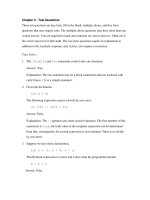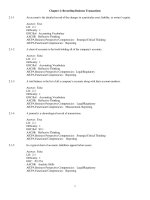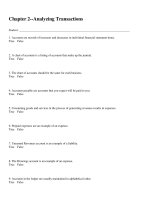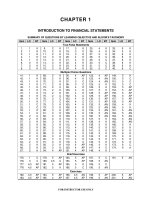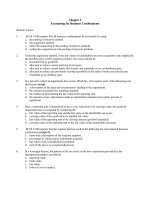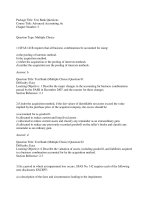Advanced accounting 5th edition jeter test bank
Bạn đang xem bản rút gọn của tài liệu. Xem và tải ngay bản đầy đủ của tài liệu tại đây (371.15 KB, 17 trang )
Chapter 2
Accounting for Business Combinations
Multiple Choice
1.
SFAS 141R requires that all business combinations be accounted for using
a. the pooling of interests method.
b. the acquisition method.
c. either the acquisition or the pooling of interests methods.
d. neither the acquisition nor the pooling of interests methods.
2.
Under the acquisition method, if the fair values of identifiable net assets exceed the value implied by
the purchase price of the acquired company, the excess should be
a. accounted for as goodwill.
b. allocated to reduce current and long-lived assets.
c. allocated to reduce current assets and classify any remainder as an extraordinary gain.
d. allocated to reduce any previously recorded goodwill on the seller’s books and classify any
remainder as an ordinary gain.
3.
In a period in which an impairment loss occurs, SFAS No. 142 requires each of the following note
disclosures except
a. a description of the facts and circumstances leading to the impairment.
b. the amount of goodwill by reporting segment.
c. the method of determining the fair value of the reporting unit.
d. the amounts of any adjustments made to impairment estimates from earlier periods, if
significant.
4.
Once a reporting unit is determined to have a fair value below its carrying value, the goodwill
impairment loss is computed by comparing the
a. fair value of the reporting unit and the fair value of the identifiable net assets.
b. carrying value of the goodwill to its implied fair value.
c. fair value of the reporting unit to its carrying amount (goodwill included).
d. carrying value of the reporting unit to the fair value of the identifiable net assets.
5.
SFAS 141R requires that the acquirer disclose each of the following for each material business
combination except the
a. name and a description of the acquiree acquired.
b. percentage of voting equity instruments acquired.
c. fair value of the consideration transferred.
d. each of the above is a required disclosure
6.
In a leveraged buyout, the portion of the net assets of the new corporation provided by the
management group is recorded at
a. appraisal value.
b. book value.
c. fair value.
d. lower of cost or market.
2-2
Test Bank to Accompany Jeter and Chaney Advanced Accounting
7.
When the acquisition price of an acquired firm is less than the fair value of the identifiable net
assets, all of the following are recorded at fair value except
a. Assumed liabilities.
b. Current assets.
c. Long-lived assets.
d. Each of the above is recorded at fair value.
8.
Under SFAS 141R,
a. both direct and indirect costs are to be capitalized.
b. both direct and indirect costs are to be expensed.
c. direct costs are to be capitalized and indirect costs are to be expensed.
d. indirect costs are to be capitalized and direct costs are to be expensed.
9.
A business combination is accounted for properly as an acquisition. Which of the following
expenses related to effecting the business combination should enter into the determination of net
income of the combined corporation for the period in which the expenses are incurred?
a.
b.
c.
d.
10.
Security
issue costs
Yes
Yes
No
No
Overhead allocated
to the merger
Yes
No
Yes
No
In a business combination, which of the following costs are assigned to the valuation of the
security?
a.
b.
c.
d.
Professional or
consulting fees
Yes
Yes
No
No
Security
issue costs
Yes
No
Yes
No
11.
Parental Company and Sub Company were combined in an acquisition transaction. Parental was
able to acquire Sub at a bargain price. The sum of the fair values of identifiable assets acquired less
the fair value of liabilities assumed exceeded the cost to Parental. After eliminating previously
recorded goodwill, there was still some "negative goodwill." Proper accounting treatment by
Parental is to report the amount as
a. paid-in capital.
b. a deferred credit, which is amortized.
c. an ordinary gain.
d. an extraordinary gain.
12.
With an acquisition, direct and indirect expenses are
a. expensed in the period incurred.
b. capitalized and amortized over a discretionary period.
c. considered a part of the total cost of the acquired company.
d. charged to retained earnings when incurred.
Chapter 2 Accounting for Business Combinations
2-3
13.
In a business combination accounted for as an acquisition, how should the excess of fair value of net
assets acquired over the consideration paid be treated?
a. Amortized as a credit to income over a period not to exceed forty years.
b. Amortized as a charge to expense over a period not to exceed forty years.
c. Amortized directly to retained earnings over a period not to exceed forty years.
d. Recorded as an ordinary gain.
14.
P Corporation issued 10,000 shares of common stock with a fair value of $25 per share for all the
outstanding common stock of S Company in a business combination properly accounted for as an
acquisition. The fair value of S Company's net assets on that date was $220,000. P Company also
agreed to issue an additional 2,000 shares of common stock with a fair value of $50,000 to the
former stockholders of S Company as an earnings contingency. Assuming that the contingency is
expected to be met, the $50,000 fair value of the additional shares to be issued should be treated as
a(n)
a. decrease in noncurrent liabilities of S Company that were assumed by P Company.
b. decrease in consolidated retained earnings.
c. increase in consolidated goodwill.
d. decrease in consolidated other contributed capital.
15.
On February 5, Pryor Corporation paid $1,600,000 for all the issued and outstanding common stock
of Shaw, Inc., in a transaction properly accounted for as an acquisition. The book values and fair
values of Shaw's assets and liabilities on February 5 were as follows
Cash
Receivables (net)
Inventory
Plant and equipment (net)
Liabilities
Net assets
Book Value
$ 160,000
180,000
315,000
820,000
(350,000)
$1,125,000
Fair Value
$ 160,000
180,000
300,000
920,000
(350,000)
$1,210,000
What is the amount of goodwill resulting from the business combination?
a. $-0-.
b. $475,000.
c. $85,000.
d. $390,000.
16.
P Company purchased the net assets of S Company for $225,000. On the date of P's purchase, S
Company had no investments in marketable securities and $30,000 (book and fair value) of
liabilities. The fair values of S Company's assets, when acquired, were
Current assets
Noncurrent assets
Total
$ 120,000
180,000
$300,000
How should the $45,000 difference between the fair value of the net assets acquired ($270,000) and
the consideration paid ($225,000) be accounted for by P Company?
a. The noncurrent assets should be recorded at $ 135,000.
b. The $45,000 difference should be credited to retained earnings.
c. The current assets should be recorded at $102,000, and the noncurrent assets should be recorded
at $153,000.
d. An ordinary gain of $45,000 should be recorded. I would edit as D become B
2-4
Test Bank to Accompany Jeter and Chaney Advanced Accounting
17.
If the value implied by the purchase price of an acquired company exceeds the fair values of
identifiable net assets, the excess should be
a. allocated to reduce any previously recorded goodwill and classify any remainder as an ordinary
gain.
b. allocated to reduce current and long-lived assets.
c. allocated to reduce long-lived assets.
d. accounted for as goodwill.
18.
P Co. issued 5,000 shares of its common stock, valued at $200,000, to the former shareholders of S
Company two years after S Company was acquired in an all-stock transaction. The additional
shares were issued because P Company agreed to issue additional shares of common stock if the
average post combination earnings over the next two years exceeded $500,000. P Company will
treat the issuance of the additional shares as a (decrease in)
a. consolidated retained earnings.
b. consolidated goodwill.
c. consolidated paid-in capital.
d. non-current liabilities of S Company assumed by P Company.
The fair value of assets and liabilities of the acquired entity is to be reflected in the financial
statements of the combined entity. When the acquisition takes place over a period of time rather
than all at once, at what time is the fair value of the assets and liabilities of the acquired entity
determined under SFAS 141R?
a. the date the interest in the acquiree was acquired.
b. the date the acquirer obtains control of the acquiree
c. the date of acquisition of the largest portion of the interest in the acquiree.
d. the date of the financial statements.
19.
20.
The first step in determining goodwill impairment involves comparing the
a. implied value of a reporting unit to its carrying amount (goodwill excluded).
b. fair value of a reporting unit to its carrying amount (goodwill excluded).
c. implied value of a reporting unit to its carrying amount (goodwill included).
d. fair value of a reporting unit to its carrying amount (goodwill included).
21.
If an impairment loss is recorded on previously recognized goodwill due to the transitional goodwill
impairment test, the loss should be treated as a(n):
a. loss from a change in accounting principles.
b. extraordinary loss
c. loss from continuing operations.
d. loss from discontinuing operations.
22.
P Company acquires all of the voting stock of S Company for $930,000 cash. The book values of S
Company’s assets are $800,000, but the fair values are $840,000 because land has a fair value above
its book value. Goodwill from the combination is computed as:
a. $130,000.
b. $90,000.
c. $40,000.
d. $0.
Chapter 2 Accounting for Business Combinations
23.
2-5
Under SFAS 141R, what value of the assets and liabilities is reflected in the financial statements on
the acquisition date of a business combination?
a. Carrying value
b. Fair value
c. Book value
d. Average value
Use the following information to answer questions 24 & 25.
North Company issued 24,000 shares of its $20 par value common stock for the net assets of Prairie
Company in business combination under which Prairie Company will be merged into North Company. On
the date of the combination, North Company common stock had a fair value of $30 per share. Balance
sheets for North Company and Prairie Company immediately prior to the combination were as follows:
North
Prairie
Current Assets
Plant and Equipment (net)
Total
$1,314,000
1,725,000
$3,039,000
$192,000
408,000
$600,000
Liabilities
Common Stock, $20 par value
Other Contributed Capital
Retained Earnings
Total
$ 900,000
1,650,000
218,000
271,000
$3,039,000
$150,000
240,000
60,000
150,000
$600,000
24.
If the business combination is treated as an acquisition and Prairie Company’s net assets have a fair
value of $686,400, North Company’s balance sheet immediately after the combination will include
goodwill of
a. $30,600.
b. $38,400.
c. $33,600.
d. $56,400.
25.
If the business combination is treated as an acquisition and the fair value of Prairie Company’s
current assets is $270,000, its plant and equipment is $726,000, and its liabilities are $168,000,
North Company’s financial statements immediately after the combination will include
a. Negative goodwill of $108,000.
b. Plant and equipment of $2,133,000.
c. Plant and equipment of $2,343,000.
d. An ordinary gain of $108,000.
2-6
26.
Test Bank to Accompany Jeter and Chaney Advanced Accounting
On May 1, 2013, the Phil Company paid $1,200,000 for 80% of the outstanding common stock of
Sage Corporation in a transaction properly accounted for as an acquisition. The recorded assets and
liabilities of Sage Corporation on May 1, 2013, follow:
Cash
Inventory
Property & equipment (Net of accumulated depreciation)
Liabilities
$100,000
200,000
800,000
(160,000)
On May 1, 2013, it was determined that the inventory of Sage had a fair value of $220,000 and the
property and equipment (net) has a fair value of $1,200,000. What is the amount of goodwill
resulting from the business combination?
a. $0.
b. $112,000.
c. $140,000.
d. $28,000.
Use the following information to answer questions 27 & 28.
Posch Company issued 12,000 shares of its $20 par value common stock for the net assets of Sato Company
in a business combination under which Sato Company will be merged into Posch Company. On the date of
the combination, Posch Company common stock had a fair value of $30 per share. Balance sheets for Posch
Company and Sato Company immediately prior to the combination were as follows:
Posch
Sato
Current Assets
Plant and Equipment (net)
Total
$ 657,000
863,000
$1,520,000
$ 96,000
204,000
$300,000
Liabilities
Common Stock, $20 par value
Other Contributed Capital
Retained Earnings
Total
$ 450,000
825,000
109,000
136,000
$1,520,000
$ 75,000
120,000
30,000
75,000
$300,000
27.
If the business combination is treated as an acquisition and Sato Company’s net assets have a fair
value of $343,200, Posch Company’s balance sheet immediately after the combination will include
goodwill of
a. $15,300.
b. $19,200.
c. $16,800.
d. $28,200.
28.
If the business combination is treated as an acquisition and the fair value of Sato Company’s current
assets is $135,000, its plant and equipment is $363,000, and its liabilities are $84,000, Posch
Company’s financial statements immediately after the combination will include
a. Negative goodwill of $54,000.
b. Plant and equipment of $1,226,000.
c. Plant and equipment of $1,172,000.
d. An extraordinary gain of $54,000.
Chapter 2 Accounting for Business Combinations
2-7
29. Following its acquisition of the net assets of Burnt Company, PrimroseCompany assigned
goodwill of $60,000 to one of the reporting divisions. Information for this division follows:
Cash
Inventory
Equipment
Goodwill
Accounts Payable
Carrying Amount
$ 20,000
35,000
125,000
60,000
30,000
Fair Value
$20,000
40,000
160,000
30,000
Based on the preceding information, what amount of goodwill will be reported for this division if its
fair value is determined to be $200,000?
a. $0
b. $60,000
c. $30,000
d. $10,000
30.
The fair value of net identifiable assets exclusive of goodwill of a reporting unit of X Company is
$300,000. On X Company's books, the carrying value of this reporting unit's net assets is $350,000,
including $60,000 goodwill. If the fair value of the reporting unit is $335,000, what amount of
goodwill impairment will be recognized for this unit?
a. $0
b. $10,000
c. $25,000
d. $35,000
31.
The fair value of net identifiable assets of a reporting unit exclusive of goodwill of Y Company is
$270,000. The carrying value of the reporting unit's net assets on Y Company's books is $320,000,
including $50,000 goodwill. If the reported goodwill impairment for the unit is $10,000, what would
be the fair value of the reporting unit?
a. $320,000
b. $310,000
c. $270,000
d. $290,000
32. Porpoise Corporation acquired Sims Company through an exchange of common shares. All of Sims’
assets and liabilities were immediately transferred to Porpoise. Porpoise Company’s common stock was
trading at $20 per share at the time of exchange. The following selected information is also available:
Porpoise Company
Before Acquisition
After Acquisition
Par value of shares outstanding
$200,000
$250,000
Additional Paid in Capital
350,000
550,000
What number of shares was issued at the time of the exchange?
a. 5,000
b. 17,500
c. 12,500
d. 10,000
2-8
Test Bank to Accompany Jeter and Chaney Advanced Accounting
Problems
2-1
Balance sheet information for Hope Corporation at January 1, 2013, is summarized as follows:
Current assets
$ 920,000
Liabilities
$ 1,200,000
Plant assets
1,800,000
Capital stock $10 par
800,000
Retained earnings
720,000
$2,720,000
$ 2,720,000
Hope’s assets and liabilities are fairly valued except for plant assets that are undervalued by
$200,000. On January 2, 2013, Robin Corporation issues 80,000 shares of its $10 par value
common stock for all of Hope’s net assets and Hope is dissolved. Market quotations for the two
stocks on this date are:
Robin common: $28
Hope common: $19
Robin pays the following fees and costs in connection with the combination:
Finder’s fee
Costs of registering and issuing stock
Legal and accounting fees
$10,000
5,000
6,000
Required:
A. Calculate Robin’s investment cost of Hope Corporation.
B. Calculate any goodwill from the business combination.
2-2
Maplewood Corporation purchased the net assets of West Corporation on January 2, 2013 for
$560,000 and also paid $20,000 in direct acquisition costs. West’s balance sheet on January
1, 2013 was as follows:
Accounts receivable-net
Inventory
Land
Building-net
Equipment-net
Total assets
$ 180,000
360,000
40,000
60,000
80,000
$ 720,000
Current liabilities
$ 70,000
Long term debt
160,000
Common stock ($1 par)
20,000
Paid-in capital
430,000
Retained earnings
40,000
Total liab. & equity
$ 720,000
Fair values agree with book values except for inventory, land, and equipment, which have fair
values of $400,000, $50,000 and $70,000, respectively. West has patent rights valued at $20,000.
Required:
A. Prepare Maplewood’s general journal entry for the cash purchase of West’s net assets.
B. Assume Maplewood Corporation purchased the net assets of West Corporation for $500,000
rather than $560,000, prepare the general journal entry.
Chapter 2 Accounting for Business Combinations
2-3
2-9
Edina Company acquired the assets (except cash) and assumed the liabilities of Burns Company on
January 1, 2013, paying $2,600,000 cash. Immediately prior to the acquisition, Burns Company's
balance sheet was as follows:
Accounts receivable (net)
Inventory
Land
Buildings (net)
Total
BOOK VALUE
$ 240,000
290,000
960,000
1,020,000
$2,510,000
FAIR VALUE
$ 220,000
320,000
1,508,000
1,392,000
$3,440,000
Accounts payable
Note payable
Common stock, $5 par
Other contributed capital
Retained earnings
Total
$ 270,000
600,000
420,000
640,000
580,000
$2,510,000
$ 270,000
600,000
Edina Company agreed to pay Burns Company's former stockholders $200,000 cash in 2014 if postcombination earnings of the combined company reached $1,000,000 during 2013.
Required:
A. Prepare the journal entry necessary for Edina Company to record the acquisition on January 1,
2013. It is expected that the earnings target is likely to be met.
B. Prepare the journal entry necessary for Edina Company in 2014 assuming the earnings
contingency was not met.
2-4
Condensed balance sheets for Rich Company and Jordan Company on January 1, 2013 are as
follows:
Current Assets
Plant and Equipment (net)
Total Assets
Rich
$ 440,000
1,080,000
$1,520,000
Jordan
$200,000
340,000
$540,000
Total Liabilities
Common Stock, $10 par value
Other Contributed Capital
Retained Earnings
Total Equities
$ 230,000
840,000
300,000
150,000
$1,520,000
$ 80,000
240,000
130,000
90,000
$540,000
On January 1, 2013 the stockholders of Rich and Jordan agreed to a consolidation whereby a new
corporation, Cannon Company, would be formed to consolidate Rich and Jordan. Cannon Company
issued 70,000 shares of its $20 par value common stock for the net assets of Rich and Jordan. On the
date of consolidation, the fair values of Rich's and Jordan's current assets and liabilities were equal
to their book values. The fair value of plant and equipment for each company was: Rich,
$1,270,000; Jordan, $360,000.
2-10 Test Bank to Accompany Jeter and Chaney Advanced Accounting
An investment banking house estimated that the fair value of Cannon Company's common stock
was $35 per share. Rich will incur $45,000 of direct acquisition costs and $15,000 in stock issue
costs.
Required:
Prepare the journal entries to record the consolidation on the books of Cannon Company assuming
that the consolidation is accounted for as an acquisition.
2-5
The stockholders’ equities of Penn Corporation and Simon Corporation were as follows on January
1, 2013:
Common Stock, $1 par
Other Contributed Capital
Retained Earnings
Total Stockholders’ Equity
Penn Corp.
$1,000,000
2,800,000
600,000
$4,400,000
Simon Corp.
$ 600,000
1,100,000
340,000
$2,040,000
On January 2, 2013 Penn Corp. issued 100,000 of its shares with a market value of $14 per share in
exchange for all of Simon’s shares, and Simon Corp. was dissolved. Penn Corp. paid $10,000 to
register and issue the new common shares.
Required:
Prepare the stockholders’ equity section of Penn Corp. balance sheet after the business combination
on January 2, 2013.
2-6
The managers of Savage Company own 10,000 of its 100,000 outstanding common shares. Swann
Company is formed by the managers of Savage Company to take over Savage Company in a
leveraged buyout. The managers contribute their shares in Savage Company and Swann Company
then borrows $675,000 to purchase the remaining 90,000 shares of Savage Company for $600,000;
the remaining $75,000 is used for working capital. Savage Company is then merged into Swann
Company effective January 1, 2013. Data relevant to Savage Company immediately prior to the
leveraged buyout follow:
Current Assets
Plant Assets
Liabilities
Stockholders' Equity
Book Value
$ 90,000
255,000
(45,000)
$300,000
Fair Value
$ 90,000
525,000
(45,000)
$570,000
Required:
A. Prepare journal entries on Swann Company's books to reflect the effects of the leveraged
buyout.
B. Determine the balance of each of the following immediately after the merger:
1. Current Assets
2. Plant Assets
3. Note Payable
4. Common Stock
Chapter 2 Accounting for Business Combinations
2-7
2-11
On January 1, 2010, Brighton Company acquired the net assets of Dakota Company for $1,580,000
cash. The fair value of Dakota’s identifiable net assets was $1,310,000 on his date. Brighton
Company decided to measure goodwill impairment using the present value of future cash flows to
estimate the fair value of the reporting unit (Dakota). The information for these subsequent years is
as follows:
Present value
Carrying value of
Dakota’s Identifiable
Year
of Future Cash Flows
Net Assets*
Fair Value
Dakota’s
Identifiable
Net Assets
2013
2014
$1,400,000
$1,400,000
$1,160,000
$1,120,000
$1,190,000
$1,210,000
* Identifiable net assets do not include goodwill.
Required:
A: For each year determine the amount of goodwill impairment, if any.
B: Prepare the journal entries needed each year to record the goodwill impairment (if any) on
Brighton’s books.
2-8
The following balance sheets were reported on January 1, 2013, for Wood Company and Rose
Company:
Cash
Inventory
Equipment (net)
Total
Wood
$ 150,000
450,000
1,320,000
$1,920,000
Rose
$ 30,000
150,000
570,000
$750,000
Total liabilities
Common stock, $20 par value
Other contributed capital
Retained earnings
Total
$ 450,000
600,000
375,000
495,000
$1,920,000
$150,000
300,000
105,000
195,000
$750,000
Required:
Appraisals reveal that the inventory has a fair value $180,000, and the equipment has a current value
of $615,000. The book value and fair value of liabilities are the same. Assuming that Wood
Company wishes to acquire Rose for cash in an asset acquisition, determine the following cutoff
amounts:
A. The purchase price above which Wood would record goodwill.
B. The purchase price at which Wood would record a $50,000 gain.
C. The purchase price below which Wood would obtain a “bargain.”
D. The purchase price at which Wood would record $75,000 of goodwill.
Short Answer
1.
SFAS No. 142 requires that goodwill impairment be tested annually for each reporting unit. Discuss
the necessary steps of the goodwill impairment test.
2-12 Test Bank to Accompany Jeter and Chaney Advanced Accounting
2. Briefly describe the different treatment under SFAS 141 vs. SFAS 141R for the following issues:
Business definition
Acquisition costs
In-process R&D
Contingent consideration
Short Answer Questions from the Textbook
1. When contingent consideration in an acquisition is based on security prices, how should this
contingency be reflected on the acquisition date? If the estimate changes during the measurement
period, how is this handled? If the estimate changes after the end of the measurement period, how is this
adjustment handled? Why?
2. What are pro forma financial statements? What is their purpose?
3. How would a company determine whether goodwill has been impaired?
4. AOL announced that because of an accounting change (FASB Statements Nos. 141R [ASC 805] and142
[ASC 350]), earnings would be increasing over the next 25 years by $5.9 billion a year. What change(s)
required by FASB (in SFAS Nos. 141Rand 142) resulted in an increase in AOL’s in-comeincome?
Would you expect this increase in earnings to have a positive impact on AOL’s stock price? Why or
why not?
Business Ethics Question from Textbook
There have been several recent cases of a CEO or CFO resigning or being ousted for misrepresenting
academic credentials. For instance, during February 2006,the CEO of RadioShack resigned by ‘mutual
agreement’ for inflating his educational background. During 2002, Veritas Software Corporation’s CFO
resigned after claiming to have an MBA from Stanford University. On the other hand, Bausch & Lomb
Inc.’s board refused the CEO’s offer to resign following a questionable claim to have an MBA.
Suppose you have been retained by the board of a company where the CEO has ‘overstated’ credentials.
This company has a code of ethics and conduct which states that the employee should always do “the right
thing.”(a) What is the board of directors’ responsibility in such matters?(b) What arguments would you
make to ask the CEO to resign? What damage might be caused if the decision is made to retain the current
CEO?
Chapter 2 Accounting for Business Combinations
ANSWER KEY
Multiple Choice
1.
2.
3.
4.
5.
6.
7.
8.
9.
b
d
b
b
d
b
d
b
c
10.
11.
12.
13.
14.
15.
16.
17.
18.
c
c
a
d
c
d
dsee note on p3
d
c
19.
20.
21.
22.
23.
24.
25.
26.
27.
b
d
a
b
b
c
d
c
c
28. b
29. d
30. c
31. b
32. c
Problems
2-1
A. FMV of shares issued by Robin (80,000 sh × $28) =
$2,240,000
B. Investment cost from Part A
$2,240,000
Less: Fair value of Hope’s net assets ($2,720,000+$200,000–$1,200,000) 1,720,000
Goodwill from investment
$ 520,000
2-2
A. Accounts Receivable
Inventory
Land
Building
Equipment
Patent
Goodwill
Acquisition Expense
Current Liabilities
Long-term Debt
Cash
180,000
400,000
50,000
60,000
70,000
20,000
10,000
20,000
B. Acquisition Expense
Accounts Receivable
Inventory
Land
Building
Equipment
Patent
Current Liabilities
Long-term Debt
Cash
Gain on Acquisition
20,000
180,000
400,000
50,000
60,000
70,000
20,000
70,000
160,000
580,000
70,000
160,000
520,000
50,000
2-13
2-14 Test Bank to Accompany Jeter and Chaney Advanced Accounting
2-3
A. Accounts Receivable
Inventory
Land
Buildings
Goodwill
Allowance for Uncollectible Accounts
Accounts Payable
Note Payable
Cash
240,000
320,000
1,508,000
1,392,000
30,000
Goodwill
Liability for Contingent Consideration
200,000
Cost of acquisition
Fair value of net assets acquired
($3,440,000 – $870,000)
Goodwill
2-5
200,000
$2,600,000
2,570,000
$ 30,000
B. Liability for Contingent Consideration
Income from Change in Estimate
2-4
20,000
270,000
600,000
2,600,000
200,000
200,000
Current Assets ($440,000 + $200,000)
640,000
Plant and Equipment ($1,270,000 + $360,000) 1,630,000
Goodwill
490,000
Liabilities ($230,000 + $80,000)
Common Stock
(70,000 shares @ $20/share)
Other Contributed Capital
(70,000 × ($35 – $20))
Acquisition Expense
Cash
45,000
Other Contributed Capital
Cash
15,000
Stockholders’ Equity:
Common Stock, $1 par
Other Contributed Capital
Retained Earnings
Total stockholders’ Equity
310,000
1,400,000
1,050,000
45,000
15,000
$1,100,000
4,090,000 [$2,800,000 + (100,000 × $13) – $10,000]
600,000
$ 5,790,000
Chapter 2 Accounting for Business Combinations
2-6
A
Investment in Savage Company ($300,000 × .10) 30,000
Common Stock
Cash
Note Payable
675,000
Investment in Savage Company
Cash
600,000
Current Assets
Plant Assets (1)
Goodwill (2)
Liabilities
Investment in Savage
90,000
498,000
87,000
2-15
30,000
675,000
600,000
45,000
630,000
(1) $255,000 + [.90 × ($525,000 – $255,000)] = $498,000
(2) Cost of shares
Book value of net assets (.90 × $300,000) =
Difference between cost and book value
Allocated to:
Plant assets (.90 × ($525,000 – $255,000)) =
Goodwill
B
1.
2.
3.
4.
2-7
Current Assets ($90,000 + $75,000)
Plant Assets ($255,000 + $243,000)
Note Payable
Common Stock
$600,000
270,000
$330,000
243,000
87,000
165,000
498,000
675,000
30,000
A.
2013: Step 1: Fair value of the reporting unit
Carrying value of unit:
Carrying value of identifiable net assets
$1,160,000
Carrying value of goodwill ($1,580,000 – $1,310,000)
270,000
Excess of carrying value over fair value
The excess of carrying value over fair value means that step 2 is required.
Step 2: Fair value of the reporting unit
Fair value of identifiable net assets
Implied value of goodwill
Recorded value of goodwill ($1,580,000 – $1,310,000)
Impairment loss
2014: Step 1: Fair value of the reporting unit
Carrying value of unit:
Carrying value of identifiable net assets
Carrying value of goodwill ($270,000 – $40,000)
$1,400,000
1,430,000
$30,000
$1,400,000
1,190,000
210,000
270,000
$60,000
$1,400,000
$1,120,000
230,000
1,350,000
2-16 Test Bank to Accompany Jeter and Chaney Advanced Accounting
Excess of Fair value over Carrying value
$ 50,000
The excess of fair value over carrying value means that step 2 is not required.
B.
2013:
2014:
2-8
Impairment Loss—Goodwill
Goodwill
60,000
60,000
No entry
a. Fair Value of Identifiable Net Assets
Book values $750,000 – $150,000 =
Write up of Inventory and Equipment:
($30,000 + $45,000) =
Purchase price above which goodwill would result
$600,000
75,000
$675,000
b. Any existing goodwill would be eliminated before recording a gain:
$675,000 Fair Value of Identifiable Net Assets – $50,000 Gain = $625,000.
c. Anything below $675,000 is technicially considered a bargain.
d. Goodwill would be $75,000 at a purchase price of $750,000 or ($675,000 + $75,000).
Short Answer
1.
In the first step of the goodwill impairment test, the fair value of the reporting unit is compared to its
carrying amount. If the fair value is less than the carrying amount, then the carrying value of the
goodwill is compared to its implied fair value. A loss is recognized when the carrying value of
goodwill is higher than its fair value.
2.
Issue
Business
definition
SFAS No. 141
A business is defined as a self-sustaining
integrated set of activities and assets
conducted and managed for the purpose of
providing a return to investors. The
definition would exclude early-stage
development entities.
Acquisition
costs
Capitalize the costs.
SFAS No. 141R
A business or a group of assets no
longer must be self-sustaining. The
business or group of assets must be
capable of generating a revenue
stream. This definition would
include early-stage development
entities.
Expense as incurred.
In-process
R&D
Included as part of purchase price, but then
immediately expensed.
Included as part of purchase price,
treated as an asset.
Contingent
Record when determinable and reflect
consideration subsequent changes in the purchase price.
Record at fair value on the
acquisition date with subsequent
changes recorded on the income
statement.
Chapter 2 Accounting for Business Combinations
2-17
Short Answer Questions from the Textbook Solutions
1.
At the acquisition date, the information available (and through the end of the measurement period) is
used to estimate the expected total consideration at fair value. If the subsequent stock issue valuation
differs from this assessment, the Exposure Draft (SFAS 1204-001) expected to replace FASB Statement
No. 141R specifies that equity should not be adjusted. The reason is that the valuation was determined
at the date of the exchange, and thus the impact on the firm’s equity was measured at that point based
on the best information available then.
2.
Pro forma financial statements (sometimes referred to as “as if” statements) are financial statements
that are prepared to show the effect of planned or contemplated transactions.
3.
For purposes of the goodwill impairment test, all goodwill must be assigned to a reporting unit.
Goodwill impairment for each reporting unit should be tested in a two-step process. In the first step,
the fair value of a reporting unit is compared to its carrying amount (goodwill included) at the date of
the periodic review. The fair value of the unit may be based on quoted market prices, prices of
comparable businesses, or a present value or other valuation technique. If the fair value at the review
date is less than the carrying amount, then the second step is necessary. In the second step, the carrying
value of the goodwill is compared to its implied fair value. (The calculation of the implied fair value of
goodwill used in the impairment test is similar to the method illustrated throughout this chapter for
valuing the goodwill at the date of the combination.)
4.
The expected increase was due to the elimination of goodwill amortization expense. However, the
impairment loss under the new rules was potentially larger than a periodic amortization charge, and this
is in fact what materialized within the first year after adoption (a large impairment loss). If there was
any initial stock price impact from elimination of goodwill amortization, it was only a short-term or
momentum effect. Another issue is how the stock market responds to the goodwill impairment charge.
Some users claim that this charge is a non-cash charge and should be disregarded by the market.
However, others argue that the charge is an admission that the price paid was too high, and might result
in a stock price decline (unless the market had already adjusted for this overpayment prior to the actual
write down).
ANSWERS TO BUSINESS ETHICS CASE
a and b. The board has responsibility to investigate anything that might suggest malfeasance or inappropriate
conduct. Such incidents suggest broader problems with integrity, honesty, and judgment. In other words,
can you trust any reports from the CEO that lied on his resume? If the CEO is not fired, what kind of
message does this send to other employees? Employees will feel that top executives are not subject to the
same standards of ethical conduct as they are.
